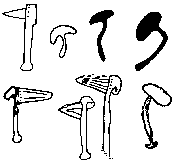The Supreme Court's opinion on religious hallucinogens
Click on the above link to read an article highlighting the breadth of knowledge exercised by the U.S. Supreme Court regarding the religious nature of psychotropic entheogens.
(hint- it's a bit like using Latin to rap. Don't get the simile? Just read the article, bearing in mind that while the legal Sadduccees debate, the law is at work fostering shadow economies and catalyzing an atmosphere of ontological oppression.)
The real issue in the case is not whether Schedule I, as a whole, needs to be uniformly enforced, because the drugs covered by Schedule I are quite different from one another: Schedule I encompasses a variety of chemicals, which - while they may be similar in danger as a general category -- are not similar in effect, use for recreational purposes, potential for addiction, source, effect on children, or in their effect on international trafficking. Had the UDV asked for heroin or marijuana (as other churches have), this point would have been patently obvious.
Rather, the issue is whether the ban for each of these dangerous drugs needs to be uniformly enforced - that is, enforced the same no matter who the would-be user is, or what his or her reason for using may be. Indeed, it may be true, roughly, that the greater the danger, the more reluctant the government ought to be in allowing departures from uniformity of application.
A Peyote Exemption Does Not Entail a Heroin Exemption
Put another way, the exemption for peyote shows only that the government is willing to tolerate use of peyote - with all of its individual characteristics -- within the United States, not that it must be willing to tolerate religious exemptions to prohibitions on other Schedule 1 drugs, like heroin or marijuana or DMT.
The reason many states and the federal government have been willing to exempt religious peyote use is because it is not a terribly pleasant drug -- reportedly often causing headaches and nausea, and rather unreliable in its effect. Thus, it is not a desirable recreational drug with an active black market. Moreover, it is domestically grown, which relieves the United States of its obligations under the UN treaty.
The same cannot be said for DMT, about which much less is known, and which is grown in South America, raising the United States' obligations under the UN's treaty. The potential for this relatively new hallucinogen in the United States to foster an active black market simply is not known.
The author of this article knows too much about law and too little about humanity's spiritual and medicinal ancestry. The "dangerous drugs" she mentions are really no more dangerous than many socially accepted prescription drugs, and no more addictive than alcohol or cigarettes. But then, such great mis-information as the kind expressed in Marci Hamilton's article is clearly evident in the thoughts and suggestions of the members of the Supreme Court. How long will American legislators and judges draw such ignorant conclusions and repress the promises of the Bill of Rights?
 the world is what we make it
the world is what we make it
























0 Comments:
Post a Comment
<< Home